Chaukhira: Difference between revisions
| Line 383: | Line 383: | ||
{{Audonia topics}} | {{Audonia topics}} | ||
[[Category: Burgundie]] | [[Category: Burgundie]] | ||
[[Category: Sub-national Regions in Burgundie]] | [[Category: Sub-national Regions in Burgundie]] | ||
Revision as of 14:05, 3 January 2023
This article is a work-in-progress because it is incomplete and pending further input from an author. Note: The contents of this article are not considered canonical and may be inaccurate. Please comment on this article's talk page to share your input, comments and questions. |
Script error: The module returned a nil value. It is supposed to return an export table.
Trade Island of Chaukira
Chaukhira | |
|---|---|
| Nation | |
| Constituent Country equivalent | Burgoignesc Overseas Territory Assembly |
| Geographic Designation | Audonio-Alshari Burgundie |
| Capital | Abu-Ouncanobi |
| Government | |
| • Governor-Epistates | Marcel-Anwar bin Qadafim |
| Area | |
| • Total | 9,194.458 km2 (3,550.000 sq mi) |
| Population (2025) | |
| • Total | 7,054,493 |
| • Density | 767.25/km2 (1,987.2/sq mi) |
| Demonym | Chaukhiroise |
Geography
Geology
Chaukhira is an archipelago of 5 islands in the southern mouth of the Aab-e-Farus. The waters around the islands are called the al-Zelaq Straits.
The largest and most western island is called Chaukhira Maior (the small island off of it's northeastern coast is called Chaukhira Minor and is hardly referenced uniquely). The second largest, to the northeast is Taizerbo, the smallest to the extreme north east is Taoulga, coming back to the southwest is Ghat, and in the center of the island cluster is Akhdaran.
The islands are the remains of a land bridge that used to connect the southern two continental islands of Alshar. At the end of the last ice age when sea levels rose, the Aab-e-Farus overtopped the lower laying areas of the land bridge and only the islands of Chaukhira and those big islands to the south remain.
Because of this phenomenon, the geography that remains to form the island chain is hilly with low lying areas being built up by silty undercurrents coming from the Aab-e-Farus. This makes the northern coasts very fertile and verdant. The northern faces of the hilly landscape is also quite fertile as the Antarctic atmosphere pulls warm air out of the Aab-e-Farus]] extending the growing season and keeping it humid year round.
Over the past few thousand years of human settlement the nutrient rich silt has been spread throughout the islands, but the heavily rains in the monsoon season rapidly errode anything that is not secured by deep roots. As such much of the islands hillsides have been terraced for cultivation and rivers and streams have been the subject of extensive terraforming and human intervention.
Climate
Chaukhira has a Tropical rainforest climate climate zone with significant rainfall even in its driest months. The climate is hot and humid with a lot of rainfall throughout the year. The annual average temperature is around 27.3 °C (81.1 °F). Except for precipitation and monsoonal wind direction, Chaukhira experiences no other seasonal change throughout the year. The average rainfall annually is 2,623 millimeters or 103 inches. During its wettest months, the provinces lowlands are frequently inundated by torrential rains. However, in its driest months, many regional peatlands dry out, making them more vulnerable to wildfires, and causing prolonged haze in the direr months.
| Climate data for Chaukhira | |||||||||||||
|---|---|---|---|---|---|---|---|---|---|---|---|---|---|
| Month | Jan | Feb | Mar | Apr | May | Jun | Jul | Aug | Sep | Oct | Nov | Dec | Year |
| Average high °C (°F) | 30.8 (87.4) |
31.2 (88.2) |
31.5 (88.7) |
32.1 (89.8) |
32.4 (90.3) |
31.9 (89.4) |
31.8 (89.2) |
32.1 (89.8) |
32.5 (90.5) |
32.6 (90.7) |
31.9 (89.4) |
31.1 (88.0) |
31.8 (89.3) |
| Daily mean °C (°F) | 26.8 (80.2) |
27.1 (80.8) |
27.2 (81.0) |
27.7 (81.9) |
28.0 (82.4) |
27.4 (81.3) |
27.0 (80.6) |
27.2 (81.0) |
27.5 (81.5) |
27.7 (81.9) |
27.4 (81.3) |
27.0 (80.6) |
27.3 (81.2) |
| Average low °C (°F) | 22.9 (73.2) |
23.0 (73.4) |
23.0 (73.4) |
23.4 (74.1) |
23.6 (74.5) |
22.9 (73.2) |
22.3 (72.1) |
22.4 (72.3) |
22.5 (72.5) |
22.9 (73.2) |
23.0 (73.4) |
23.0 (73.4) |
22.9 (73.2) |
| Average rainfall mm (inches) | 277 (10.9) |
262 (10.3) |
329 (13.0) |
263 (10.4) |
213 (8.4) |
122 (4.8) |
104 (4.1) |
107 (4.2) |
120 (4.7) |
186 (7.3) |
274 (10.8) |
366 (14.4) |
2,623 (103.3) |
| Mean monthly sunshine hours | 169 | 118 | 130 | 150 | 174 | 127 | 131 | 149 | 118 | 160 | 132 | 120 | 1,678 |
| [citation needed] | |||||||||||||
Flora
Fauna
History
Geological history
Early settlements
Pre-Occidental history
Late modern period
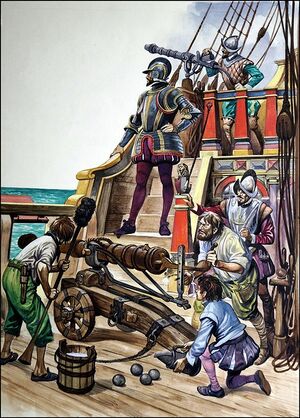 |
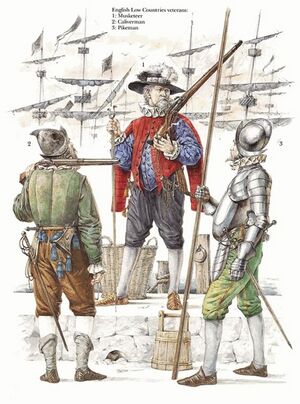 |
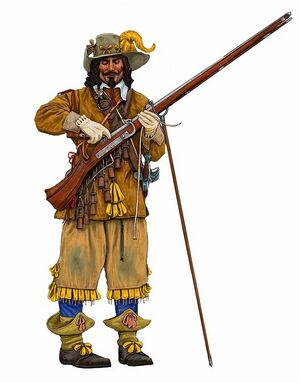 |
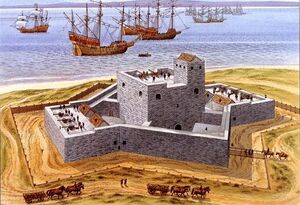 |
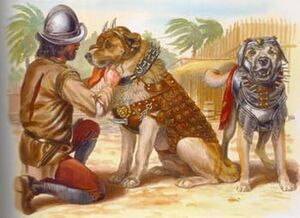 |
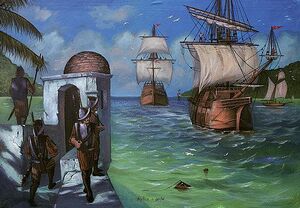 |
- Coffee plantation
- Coaling station
- Rubber plantation
Contemporary period
Second Great War
During the Second Great War (1934 to 1943), Chaukhira was the site of a number of operations initiated by both Burgundie and Caphiria through its proxy Zaclaria. In 1937, Zaclarian forces invaded the Chaukhiroise island of Taoulga which they were able to hold for the duration of the war.
Politics
Chaukhira is part of the Burgoignesc Overseas Territory Assembly's Audonio-Alshari Burgundie geographic designation. Burgoignesc Overseas Territory Assembly is a constituent country equivalent of Burgundie with its own assembly, prime minister, budget, and laws. Burgundie's national governmental influence is limited to subsidies, education, and security, however, its financial and cultural institutes cast a long shadow across Sudmoll.
Chaukhira is a province within Burgoignesc Overseas Territory Assembly with its own semi-elected Governor-Epistates, representative legislative body, and court system.
Chaukhiroise are Burgoigniacs/Burgoignix with complete civil and economic rights, and citizenship (political rights) under the same federal service criteria as all residents of Burgundie. Burgoignesc is the official language but Arabic and Burgoignesc are both in use. However, there was a time during the 1960s and 1970s when children were forbidden to speak Arabic in schools. Arabic is now taught in schools; it is sometimes even a requirement for employment.
Provincial executive
The provincial executive is the Governor-Epistates. Three candidates are elected by a single transferable vote election held every 5 years, the three candidates are presented to the Court of St. Alphador and the next Governor-Epistates is chosen from these candidates. If the citizenry rejects the selection, a run-off election is held with the remaining two candidates.
Provincial legislature
Like the Citizens Court of the National Assembly (Burg. La Assemblee de Ciutadans de l'Assemblee Nacional, ACAN), The Chaukhiroise Citizen's Court of the Provincial Assembly is a unicameral legislator. It makes provincial law, has the power of the provincial purse, and has the power of impeachment, by which it can remove sitting members of the provincial government. The Assembly has three seats for each province, one for the Burgoignesc Overseas Territory Assembly's Chaukhira liaison, 3 for the clergy, 3 seats reserved for municipal leaders, and 3 for a rota of private business leaders. On 6 occasions throughout the year 3 more seats are opened to the public to debate topics that are not on the annual legislative agenda.
Provincial courts
Administrative divisions
Culture
Dance
Death
Sport
Film
Religion
Cuisine
Education
Economy
There are five sectors that encompass economic activity in Chaukhira: the processing industry, mining, agriculture, construction, and large and retail trade, and economic growth is also supported by tourism.
Employment
The agricultural sector is the cornerstone of employment in Chaukhira compared to other sectors with absorption reaching 1.9 million people. In addition to the agricultural sector, the other two sectors also absorb labor, namely the large and retail trade sector, car and motorcycle repair, and the processing industry. In the trade sector, there are 688,000 workers, and the processing industry reaches 279,300 people.
Mining
The coal deposits of Chaukhira amount to 2.24 billion tons or 48.45 percent of the total national reserves. The province also has 400 billion standard cubic feet of natural gas and 75.74 standard cubic feet of natural oil.
Tourism
Agriculture
The agricultural sector is the backbone of the economy in Chaukhira harvesting rubber, oil palm, and coffee, tea, and vegetables across 74 thousand hectares of arable land. The potential of agricultural resources is quite prominent with an annual production of rice reaching 420 thousand tons, corn production reaching 28.9 thousand tons, soybeans production reaching 1.6 thousand tons, palm oil production reaching 271.8 thousand tons, coffee (dry beans) production reaching 13.52 thousand tons, coconut production reaching 6.5 thousand tons.
Trade
| Port Abu-Oun | |
|---|---|
| Location | |
| Country | |
Infrastructure
Maritime
Roads and rail
Air
Energy and electricity
Military installations
TBD
| TBD | |
|---|---|
| | |
| Site information | |
| Owner | Burgoignesc Security Forces |
| Operator | Navy of Burgundie |
| Controlled by | TBD |
| Condition | Operational |
| Site history | |
| Built | TBD |
| Garrison information | |
| Occupants | Navy
|
Demographics
- Pages using duplicate arguments in template calls
- Pages with non-numeric formatnum arguments
- Incomplete articles
- Pages using infobox settlement with no map
- Pages using infobox settlement with no coordinates
- All articles with unsourced statements
- Articles with unsourced statements from December 2025
- Articles with invalid date parameter in template
- Pages using country topics with unknown parameters
- Burgundie
- Sub-national Regions in Burgundie
